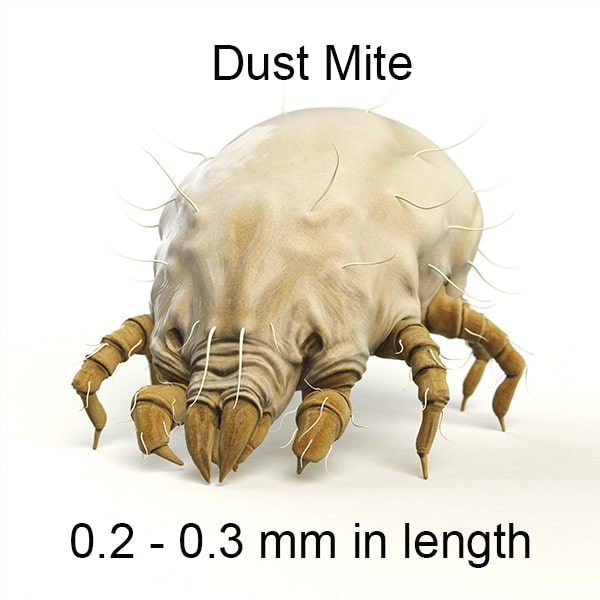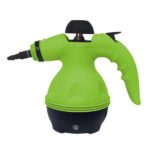
In the article
What Are Dust Mites?
House Dust Mites are microscopic organisms that generally live on dead flakes of human skin within homes, where they feed on household dust. They can eat up to half their body weight in human skin scales each day. Although they do not transmit disease, dust mites can be a serious problem for those who suffer from allergies.
Even though their minuscule size – about 50 to 100 microns (about half the width of a strand of hair ) – makes them invisible to the naked eye, they can cause allergic reactions in some people when their allergens are inhaled or touched by sensitive individuals when they are exposed to dust.
They can be found in your mattresses, pillows, and quilts, but they also live in carpets, upholstery, and curtains.
Dust Mites Habitat and Lifespan
Because their food source consists of dead skin flakes, they thrive in warm places where humidity is high.
The average life expectancy is about 2-3 months, during which time its natural predators are moths, spiders, ants, and beetles. Even though they are insects like butterflies, moths belong to the order of nocturnal Lepidoptera, while dustmites are Arthropods.
Dust Mite Allergies
The most common allergen in your home is dust. In most people, exposure to them is harmless because only a small percentage have any allergic reaction at all. The most recent studies have shown that up to 85% of people in developed countries suffer from some level of hypersensitivity.
According to medical literature, 10-20% of asthmatics and 40-60% of sufferers react badly when exposed to them. Unfortunately, there is no way for doctors or scientists to determine which individuals will develop an allergy later in life.
At least 20 million Americans suffer from allergies caused by dust mites. Allergies usually manifested as asthma attacks, rhinitis (nasal congestion), and sneezing.
Individuals suffering from asthma, bronchitis, eczema, and other allergy-related diseases are particularly sensitive to the effects of these pests in bedding and furniture.
Dust Mite Symptoms
Symptoms of an allergic reaction can occur even when there are none present at all because it’s the dried faeces that causes the allergic reaction.
According to the academic journal American Family Physician, symptoms usually appear within minutes of and include a runny or congested nose, coughing, sneezing, and a sore throat.
Individuals may develop a skin rash, watery eyes, swollen eyelids, and itchy eyes in more severe cases, while others complain of itchy skin.
In some instances – particularly if the allergy is new – people will suffer from asthma attacks instead of nasal congestion. Asthma is triggered by spasms in lung muscles that make breathing difficult due to swollen air passages (bronchial tubes) and sometimes when coughing.
Recently, researchers have discovered that exposure to their allergens can cause a person’s symptoms to worsen between six months and three years later.
In other words, people with heightened levels of exposure to this specific type of allergen could have a higher risk of developing allergies down the road. The connection between exposure and delayed reactions also suggests a possible link between asthma development and their exposure.
Currently, no study has established a definitive causal relationship between early exposure to them and the future development of asthma or allergies. Eliminating as much exposure to allergens as possible may be beneficial for individuals with respiratory problems.
It is always more challenging to find the source of your reaction if you have a pet, especially if your pet sleeps in your bedroom. Some prominent symptoms are discussed below.
People with allergies may find themselves sneezing, coughing, wheezing, and stamping their feet when they are in the presence of dus tmites.
Though not everyone is affected by exposure to these common allergens, people who do react badly will experience symptoms like
- runny nose,
- watery eyes,
- itchy skin (and irritation),
- fatigue (lack of energy),
- shortness of breath (dyspnea), vomiting (emesis),
- trouble swallowing ( dysphagia ) & trouble breathing ( dyspnea ).
Dust Mite and allergy sufferers may also experience depression due to an over-stressed immune system.
When to see the Doctor?
Individuals experiencing these symptoms should see a doctor for diagnosis and treatment options. While there is no cure for a dust-mite allergy, several medications and treatments can help manage the issue.
It’s necessary to contact a medical professional if you experience any of these symptoms to see what options could help treat your condition.
How to Prevent Exposure to Them?
To prevent exposure to household allergens, individuals should take certain precautions when cleaning their home environments. The most crucial step in reducing the amount of allergen present in a house is regular and thorough vacuuming with a HEPA-filter cleaner.
While this does not eliminate them from the environment, it can help reduce levels within household spaces while minimizing the inhalation of unwanted organisms by the home’s inhabitants.
Other measures for decreasing exposure include:
- Washing bedding weekly in hot water.
- Encase pillows, duvets and mattresses.
- Removing any objects that are currently harbouring them (e.g., carpet, curtains, stuffed animals).
Causes of Dust Mite Allergy
Dust mites are so small you can’t see them with the naked eye, but it’s not the mites themselves that cause the allergies; it’s caused by inhaling their poo. They can eat up to half their body weight in human skin scales each day.
Living with Allergies
Although they do not transmit disease, they can be a severe problem for those who suffer from allergies.
Symptoms may appear immediately or only after repeated exposure; allergy sufferers should keep track of changes in their condition, including new symptoms and worsening old ones, to determine if house dust mites might be responsible for developing any respiratory problems.
Preventive Measures
People can reduce their exposure to them by taking these steps:
– Wash sheets weekly in hot water.
– Use a high-efficiency particulate air (HEPA) filtered vacuum cleaner on all surfaces in the home.
– Remove carpets if possible; keep upholstered furniture such as couches and chairs covered (and wash the coverings regularly ).
– Make sure windows are tightly sealed.
– Repair leaky faucets and pipes to remove moisture from the air.
– Use a dehumidifier to reduce humidity levels, where possible.
– Encase pillows, duvets and mattresses in allergen-proof covers.
People with Dust Mite allergies should be aware that various treatments are available for treating these allergies. One effective treatment is allergen immunotherapy, also known as desensitization therapy.
This process involves administering tiny doses of the substance to which one is allergic over some time until it becomes clear that there is no longer a response. Another option is a class of drugs called mast cell stabilizers, which histamine receptors prevent them from being activated.
What’s Lurking In Your Mattress?
Getting a good night’s rest is essential to maintaining one’s health. Sleeping allows our bodies adequate time to rejuvenate from the stress of daily living.
Unfortunately, getting a peaceful slumber may be difficult for some people due to an allergy associated with closed-off spaces where they may thrive. These microscopic organisms live off of skin cells shed by humans and pets alike.
These pests typically reside within mattresses, bedding, upholstered furniture, and carpeted floors.
Allergies is a condition in which the body’s immune system responds to them as if they were an invading pathogen, such as a virus or bacteria. When the allergen is present, symptoms include runny nose, watery eyes, itchy skin, fatigue (lack of energy), shortness of breath (dyspnea), vomiting (emesis), trouble swallowing ( dysphagia ) & trouble breathing ( dyspnea ) may appear.
While some individuals do not experience any adverse effects from exposuret to them, others react more severely. Individuals experiencing these symptoms should see a doctor for diagnosis and treatment options. There is no cure for dust-mite allergies at this time.
Suspect a Dust Mite Allergy?
It is essential for those who suspect an allergy to see a physician for diagnosis and treatment options. Those with known allergies should avoid exposure as much as possible.
The good news is that they usually only trigger symptoms in those with an allergic predisposition; individuals without allergies may breathe them infrequently with no ill effects.
It is also worth considering that people who report problems with their allergies may be experiencing mild adverse reactions to other substances within their environment, such as mould, dander (from pets), toxins, paints, foods or other household allergens.
If you are experiencing adverse effects, it might be best to have your home checked for mould or other substances that cause similar symptoms.
Many people who think they have Dust Mite allergies may suffer from reactions to mould, dander (from pets), or other airborne irritants (e.g., cigarette smoke).
If you are experiencing adverse effects, it might be best to have your home checked for mould or other substances that cause similar symptoms.
An allergy to dust mites, usually in conjunction with allergies to mould and/or pet dander, is the most well-known cause of allergic respiratory problems. Symptoms may appear immediately or sometime later.







Leave a Reply